Social Care for Disabled: Theories, Impact, and Practitioner Framework
VerifiedAdded on 2021/04/22
|13
|3656
|105
Essay
AI Summary
This essay delves into the multifaceted realm of social care for disabled individuals, exploring the evolution of theoretical perspectives on disability, from the medical model's focus on individual limitations to the social model's emphasis on societal barriers. It examines the practical impact of these theories, including the diagnostic approach, rehabilitation, and the social perspective, while analyzing their strengths and weaknesses. The essay highlights the challenges faced by social care practitioners, such as ethical issues and the influence of existing policies, and concludes by proposing a framework for practitioners to navigate difficulties and better serve disabled individuals. It discusses the importance of understanding the social, economic, and cultural backgrounds of clients and utilizing various approaches like the social model, bio-psychological model, and economic model to provide efficient care. The essay also touches upon the tragedy of charity model and social perspective, and how these models impact the disability care practices. The essay underscores the need for a more comprehensive approach that considers both individual capabilities and societal adaptations, ensuring equal opportunities and a better quality of life for disabled persons.
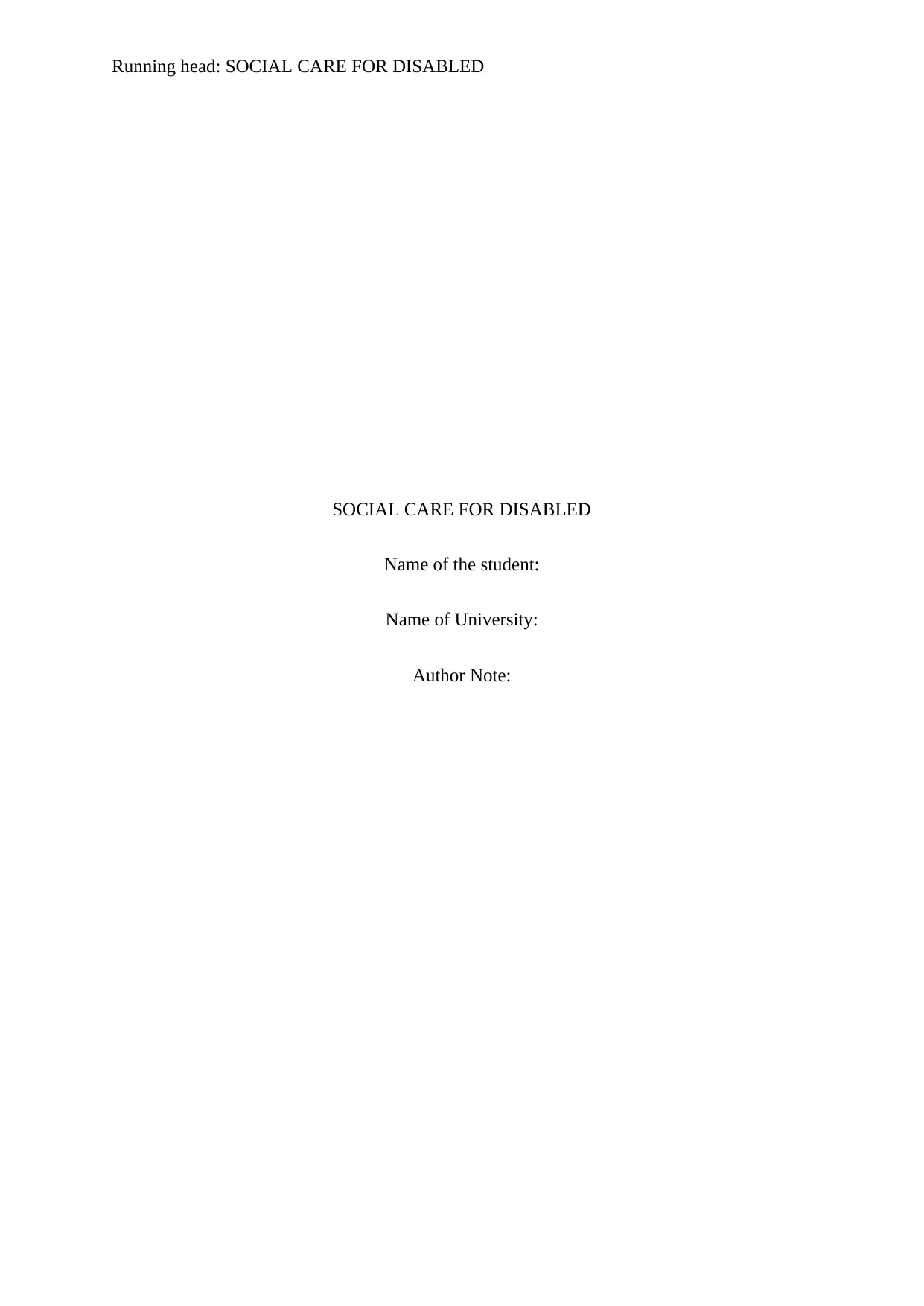
Running head: SOCIAL CARE FOR DISABLED
SOCIAL CARE FOR DISABLED
Name of the student:
Name of University:
Author Note:
SOCIAL CARE FOR DISABLED
Name of the student:
Name of University:
Author Note:
Secure Best Marks with AI Grader
Need help grading? Try our AI Grader for instant feedback on your assignments.
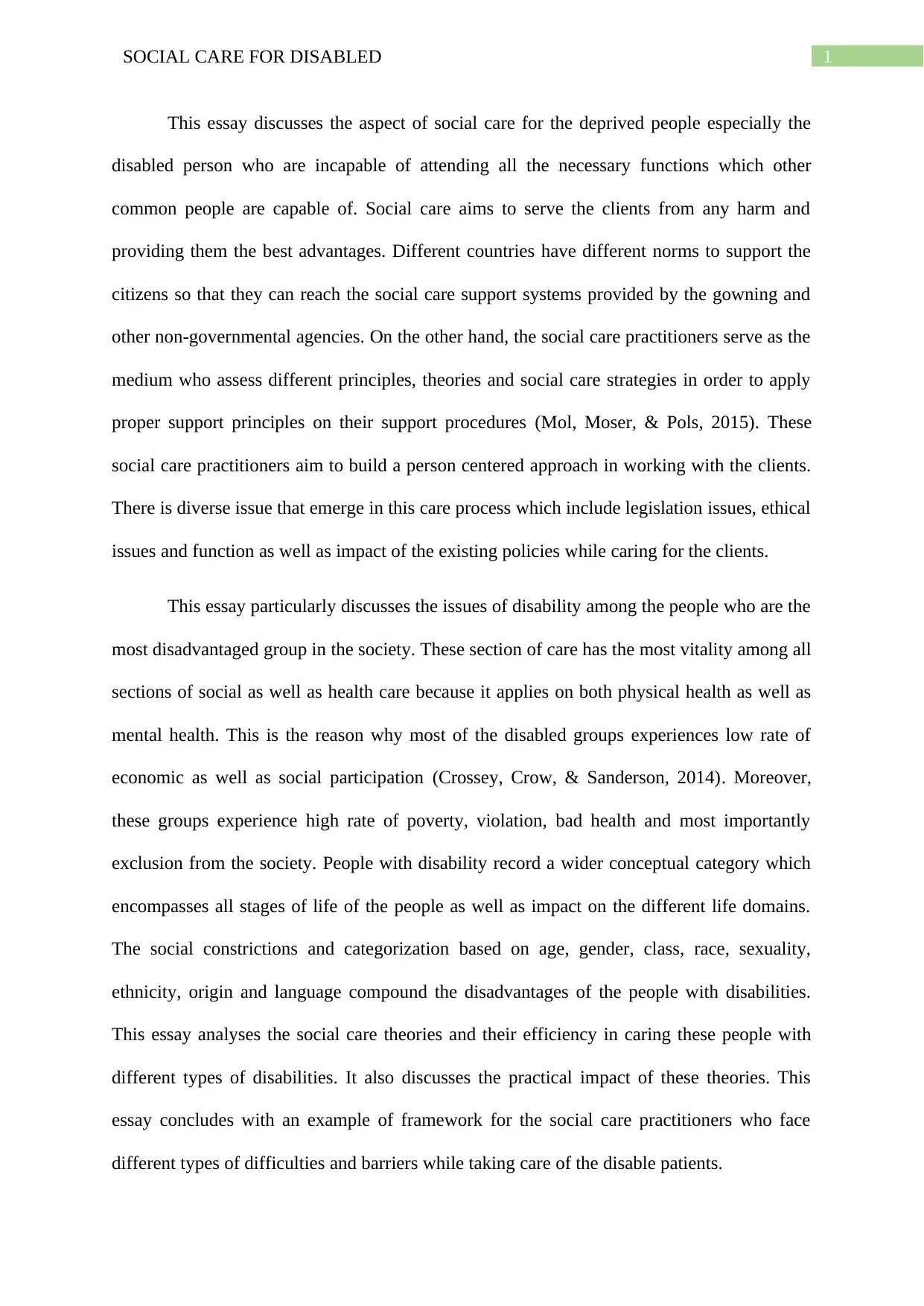
1SOCIAL CARE FOR DISABLED
This essay discusses the aspect of social care for the deprived people especially the
disabled person who are incapable of attending all the necessary functions which other
common people are capable of. Social care aims to serve the clients from any harm and
providing them the best advantages. Different countries have different norms to support the
citizens so that they can reach the social care support systems provided by the gowning and
other non-governmental agencies. On the other hand, the social care practitioners serve as the
medium who assess different principles, theories and social care strategies in order to apply
proper support principles on their support procedures (Mol, Moser, & Pols, 2015). These
social care practitioners aim to build a person centered approach in working with the clients.
There is diverse issue that emerge in this care process which include legislation issues, ethical
issues and function as well as impact of the existing policies while caring for the clients.
This essay particularly discusses the issues of disability among the people who are the
most disadvantaged group in the society. These section of care has the most vitality among all
sections of social as well as health care because it applies on both physical health as well as
mental health. This is the reason why most of the disabled groups experiences low rate of
economic as well as social participation (Crossey, Crow, & Sanderson, 2014). Moreover,
these groups experience high rate of poverty, violation, bad health and most importantly
exclusion from the society. People with disability record a wider conceptual category which
encompasses all stages of life of the people as well as impact on the different life domains.
The social constrictions and categorization based on age, gender, class, race, sexuality,
ethnicity, origin and language compound the disadvantages of the people with disabilities.
This essay analyses the social care theories and their efficiency in caring these people with
different types of disabilities. It also discusses the practical impact of these theories. This
essay concludes with an example of framework for the social care practitioners who face
different types of difficulties and barriers while taking care of the disable patients.
This essay discusses the aspect of social care for the deprived people especially the
disabled person who are incapable of attending all the necessary functions which other
common people are capable of. Social care aims to serve the clients from any harm and
providing them the best advantages. Different countries have different norms to support the
citizens so that they can reach the social care support systems provided by the gowning and
other non-governmental agencies. On the other hand, the social care practitioners serve as the
medium who assess different principles, theories and social care strategies in order to apply
proper support principles on their support procedures (Mol, Moser, & Pols, 2015). These
social care practitioners aim to build a person centered approach in working with the clients.
There is diverse issue that emerge in this care process which include legislation issues, ethical
issues and function as well as impact of the existing policies while caring for the clients.
This essay particularly discusses the issues of disability among the people who are the
most disadvantaged group in the society. These section of care has the most vitality among all
sections of social as well as health care because it applies on both physical health as well as
mental health. This is the reason why most of the disabled groups experiences low rate of
economic as well as social participation (Crossey, Crow, & Sanderson, 2014). Moreover,
these groups experience high rate of poverty, violation, bad health and most importantly
exclusion from the society. People with disability record a wider conceptual category which
encompasses all stages of life of the people as well as impact on the different life domains.
The social constrictions and categorization based on age, gender, class, race, sexuality,
ethnicity, origin and language compound the disadvantages of the people with disabilities.
This essay analyses the social care theories and their efficiency in caring these people with
different types of disabilities. It also discusses the practical impact of these theories. This
essay concludes with an example of framework for the social care practitioners who face
different types of difficulties and barriers while taking care of the disable patients.
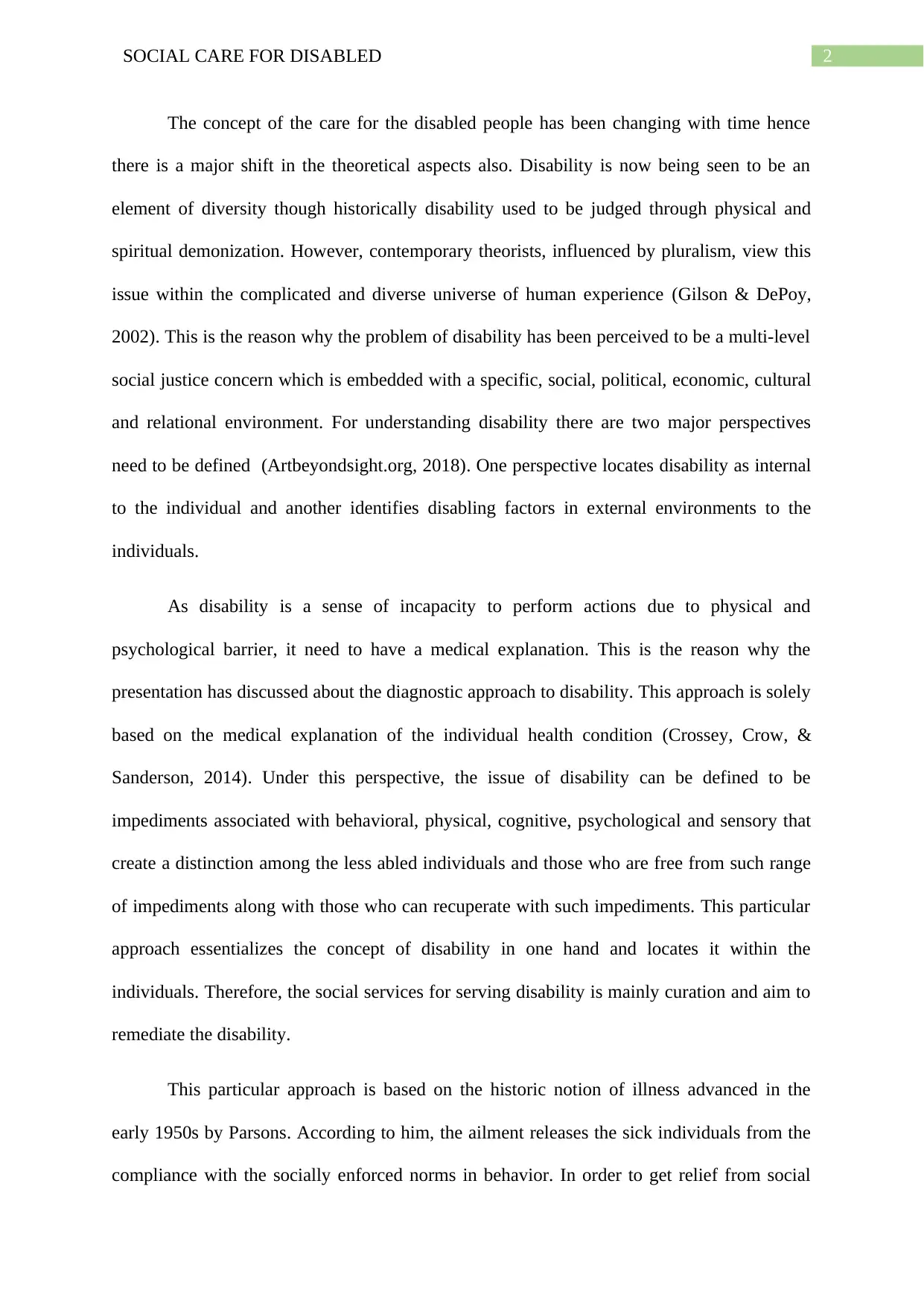
2SOCIAL CARE FOR DISABLED
The concept of the care for the disabled people has been changing with time hence
there is a major shift in the theoretical aspects also. Disability is now being seen to be an
element of diversity though historically disability used to be judged through physical and
spiritual demonization. However, contemporary theorists, influenced by pluralism, view this
issue within the complicated and diverse universe of human experience (Gilson & DePoy,
2002). This is the reason why the problem of disability has been perceived to be a multi-level
social justice concern which is embedded with a specific, social, political, economic, cultural
and relational environment. For understanding disability there are two major perspectives
need to be defined (Artbeyondsight.org, 2018). One perspective locates disability as internal
to the individual and another identifies disabling factors in external environments to the
individuals.
As disability is a sense of incapacity to perform actions due to physical and
psychological barrier, it need to have a medical explanation. This is the reason why the
presentation has discussed about the diagnostic approach to disability. This approach is solely
based on the medical explanation of the individual health condition (Crossey, Crow, &
Sanderson, 2014). Under this perspective, the issue of disability can be defined to be
impediments associated with behavioral, physical, cognitive, psychological and sensory that
create a distinction among the less abled individuals and those who are free from such range
of impediments along with those who can recuperate with such impediments. This particular
approach essentializes the concept of disability in one hand and locates it within the
individuals. Therefore, the social services for serving disability is mainly curation and aim to
remediate the disability.
This particular approach is based on the historic notion of illness advanced in the
early 1950s by Parsons. According to him, the ailment releases the sick individuals from the
compliance with the socially enforced norms in behavior. In order to get relief from social
The concept of the care for the disabled people has been changing with time hence
there is a major shift in the theoretical aspects also. Disability is now being seen to be an
element of diversity though historically disability used to be judged through physical and
spiritual demonization. However, contemporary theorists, influenced by pluralism, view this
issue within the complicated and diverse universe of human experience (Gilson & DePoy,
2002). This is the reason why the problem of disability has been perceived to be a multi-level
social justice concern which is embedded with a specific, social, political, economic, cultural
and relational environment. For understanding disability there are two major perspectives
need to be defined (Artbeyondsight.org, 2018). One perspective locates disability as internal
to the individual and another identifies disabling factors in external environments to the
individuals.
As disability is a sense of incapacity to perform actions due to physical and
psychological barrier, it need to have a medical explanation. This is the reason why the
presentation has discussed about the diagnostic approach to disability. This approach is solely
based on the medical explanation of the individual health condition (Crossey, Crow, &
Sanderson, 2014). Under this perspective, the issue of disability can be defined to be
impediments associated with behavioral, physical, cognitive, psychological and sensory that
create a distinction among the less abled individuals and those who are free from such range
of impediments along with those who can recuperate with such impediments. This particular
approach essentializes the concept of disability in one hand and locates it within the
individuals. Therefore, the social services for serving disability is mainly curation and aim to
remediate the disability.
This particular approach is based on the historic notion of illness advanced in the
early 1950s by Parsons. According to him, the ailment releases the sick individuals from the
compliance with the socially enforced norms in behavior. In order to get relief from social
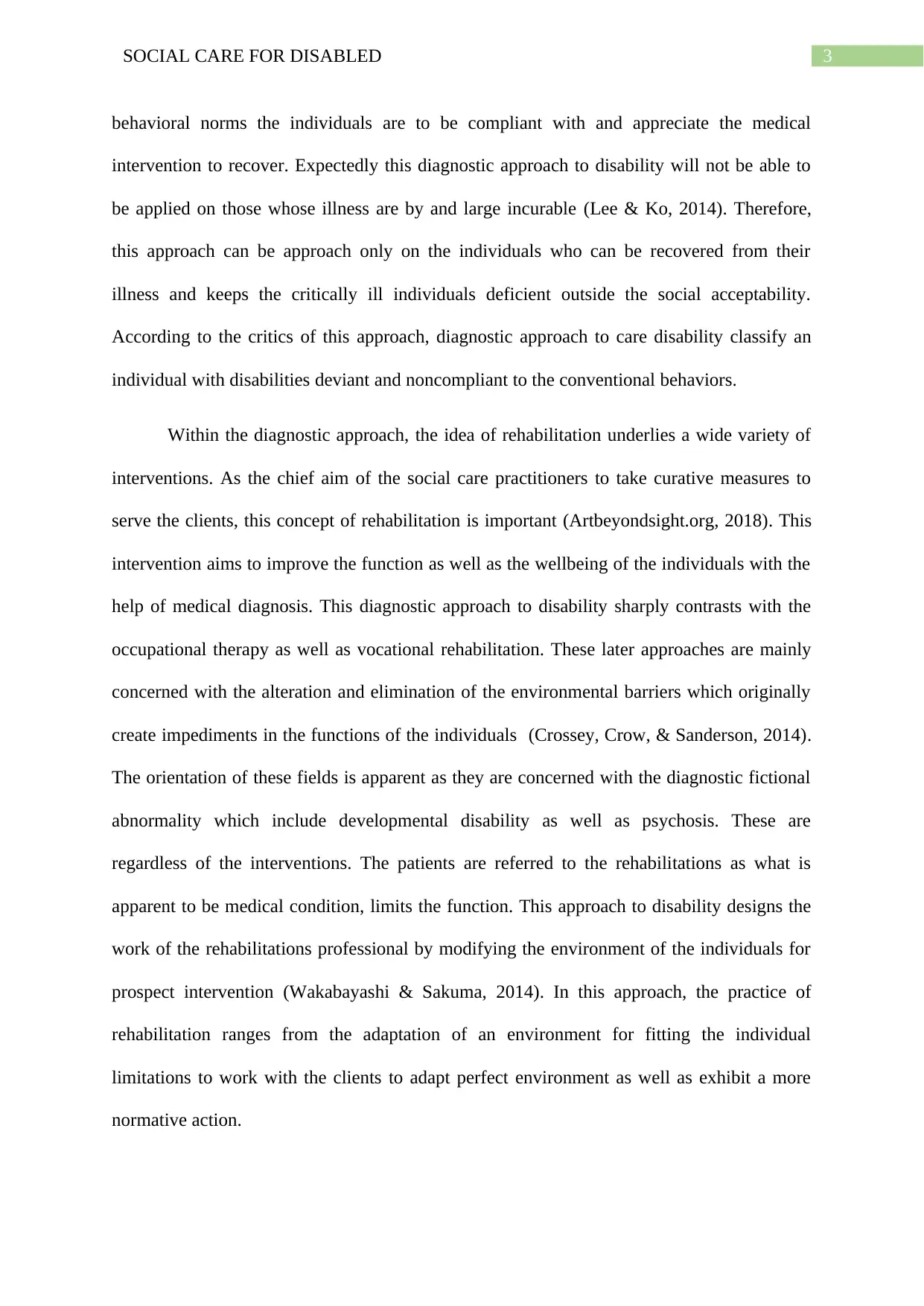
3SOCIAL CARE FOR DISABLED
behavioral norms the individuals are to be compliant with and appreciate the medical
intervention to recover. Expectedly this diagnostic approach to disability will not be able to
be applied on those whose illness are by and large incurable (Lee & Ko, 2014). Therefore,
this approach can be approach only on the individuals who can be recovered from their
illness and keeps the critically ill individuals deficient outside the social acceptability.
According to the critics of this approach, diagnostic approach to care disability classify an
individual with disabilities deviant and noncompliant to the conventional behaviors.
Within the diagnostic approach, the idea of rehabilitation underlies a wide variety of
interventions. As the chief aim of the social care practitioners to take curative measures to
serve the clients, this concept of rehabilitation is important (Artbeyondsight.org, 2018). This
intervention aims to improve the function as well as the wellbeing of the individuals with the
help of medical diagnosis. This diagnostic approach to disability sharply contrasts with the
occupational therapy as well as vocational rehabilitation. These later approaches are mainly
concerned with the alteration and elimination of the environmental barriers which originally
create impediments in the functions of the individuals (Crossey, Crow, & Sanderson, 2014).
The orientation of these fields is apparent as they are concerned with the diagnostic fictional
abnormality which include developmental disability as well as psychosis. These are
regardless of the interventions. The patients are referred to the rehabilitations as what is
apparent to be medical condition, limits the function. This approach to disability designs the
work of the rehabilitations professional by modifying the environment of the individuals for
prospect intervention (Wakabayashi & Sakuma, 2014). In this approach, the practice of
rehabilitation ranges from the adaptation of an environment for fitting the individual
limitations to work with the clients to adapt perfect environment as well as exhibit a more
normative action.
behavioral norms the individuals are to be compliant with and appreciate the medical
intervention to recover. Expectedly this diagnostic approach to disability will not be able to
be applied on those whose illness are by and large incurable (Lee & Ko, 2014). Therefore,
this approach can be approach only on the individuals who can be recovered from their
illness and keeps the critically ill individuals deficient outside the social acceptability.
According to the critics of this approach, diagnostic approach to care disability classify an
individual with disabilities deviant and noncompliant to the conventional behaviors.
Within the diagnostic approach, the idea of rehabilitation underlies a wide variety of
interventions. As the chief aim of the social care practitioners to take curative measures to
serve the clients, this concept of rehabilitation is important (Artbeyondsight.org, 2018). This
intervention aims to improve the function as well as the wellbeing of the individuals with the
help of medical diagnosis. This diagnostic approach to disability sharply contrasts with the
occupational therapy as well as vocational rehabilitation. These later approaches are mainly
concerned with the alteration and elimination of the environmental barriers which originally
create impediments in the functions of the individuals (Crossey, Crow, & Sanderson, 2014).
The orientation of these fields is apparent as they are concerned with the diagnostic fictional
abnormality which include developmental disability as well as psychosis. These are
regardless of the interventions. The patients are referred to the rehabilitations as what is
apparent to be medical condition, limits the function. This approach to disability designs the
work of the rehabilitations professional by modifying the environment of the individuals for
prospect intervention (Wakabayashi & Sakuma, 2014). In this approach, the practice of
rehabilitation ranges from the adaptation of an environment for fitting the individual
limitations to work with the clients to adapt perfect environment as well as exhibit a more
normative action.
Secure Best Marks with AI Grader
Need help grading? Try our AI Grader for instant feedback on your assignments.
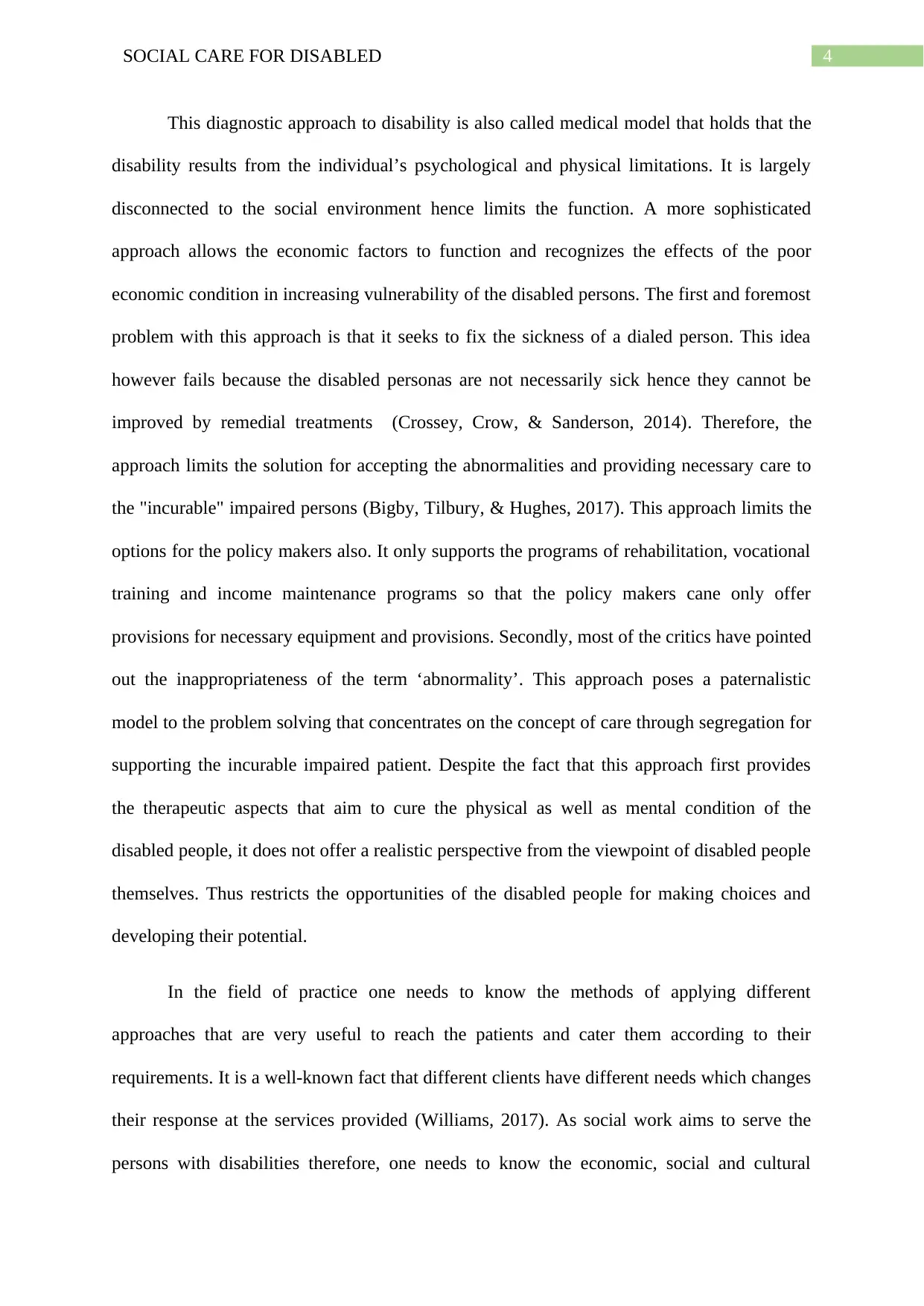
4SOCIAL CARE FOR DISABLED
This diagnostic approach to disability is also called medical model that holds that the
disability results from the individual’s psychological and physical limitations. It is largely
disconnected to the social environment hence limits the function. A more sophisticated
approach allows the economic factors to function and recognizes the effects of the poor
economic condition in increasing vulnerability of the disabled persons. The first and foremost
problem with this approach is that it seeks to fix the sickness of a dialed person. This idea
however fails because the disabled personas are not necessarily sick hence they cannot be
improved by remedial treatments (Crossey, Crow, & Sanderson, 2014). Therefore, the
approach limits the solution for accepting the abnormalities and providing necessary care to
the "incurable" impaired persons (Bigby, Tilbury, & Hughes, 2017). This approach limits the
options for the policy makers also. It only supports the programs of rehabilitation, vocational
training and income maintenance programs so that the policy makers cane only offer
provisions for necessary equipment and provisions. Secondly, most of the critics have pointed
out the inappropriateness of the term ‘abnormality’. This approach poses a paternalistic
model to the problem solving that concentrates on the concept of care through segregation for
supporting the incurable impaired patient. Despite the fact that this approach first provides
the therapeutic aspects that aim to cure the physical as well as mental condition of the
disabled people, it does not offer a realistic perspective from the viewpoint of disabled people
themselves. Thus restricts the opportunities of the disabled people for making choices and
developing their potential.
In the field of practice one needs to know the methods of applying different
approaches that are very useful to reach the patients and cater them according to their
requirements. It is a well-known fact that different clients have different needs which changes
their response at the services provided (Williams, 2017). As social work aims to serve the
persons with disabilities therefore, one needs to know the economic, social and cultural
This diagnostic approach to disability is also called medical model that holds that the
disability results from the individual’s psychological and physical limitations. It is largely
disconnected to the social environment hence limits the function. A more sophisticated
approach allows the economic factors to function and recognizes the effects of the poor
economic condition in increasing vulnerability of the disabled persons. The first and foremost
problem with this approach is that it seeks to fix the sickness of a dialed person. This idea
however fails because the disabled personas are not necessarily sick hence they cannot be
improved by remedial treatments (Crossey, Crow, & Sanderson, 2014). Therefore, the
approach limits the solution for accepting the abnormalities and providing necessary care to
the "incurable" impaired persons (Bigby, Tilbury, & Hughes, 2017). This approach limits the
options for the policy makers also. It only supports the programs of rehabilitation, vocational
training and income maintenance programs so that the policy makers cane only offer
provisions for necessary equipment and provisions. Secondly, most of the critics have pointed
out the inappropriateness of the term ‘abnormality’. This approach poses a paternalistic
model to the problem solving that concentrates on the concept of care through segregation for
supporting the incurable impaired patient. Despite the fact that this approach first provides
the therapeutic aspects that aim to cure the physical as well as mental condition of the
disabled people, it does not offer a realistic perspective from the viewpoint of disabled people
themselves. Thus restricts the opportunities of the disabled people for making choices and
developing their potential.
In the field of practice one needs to know the methods of applying different
approaches that are very useful to reach the patients and cater them according to their
requirements. It is a well-known fact that different clients have different needs which changes
their response at the services provided (Williams, 2017). As social work aims to serve the
persons with disabilities therefore, one needs to know the economic, social and cultural
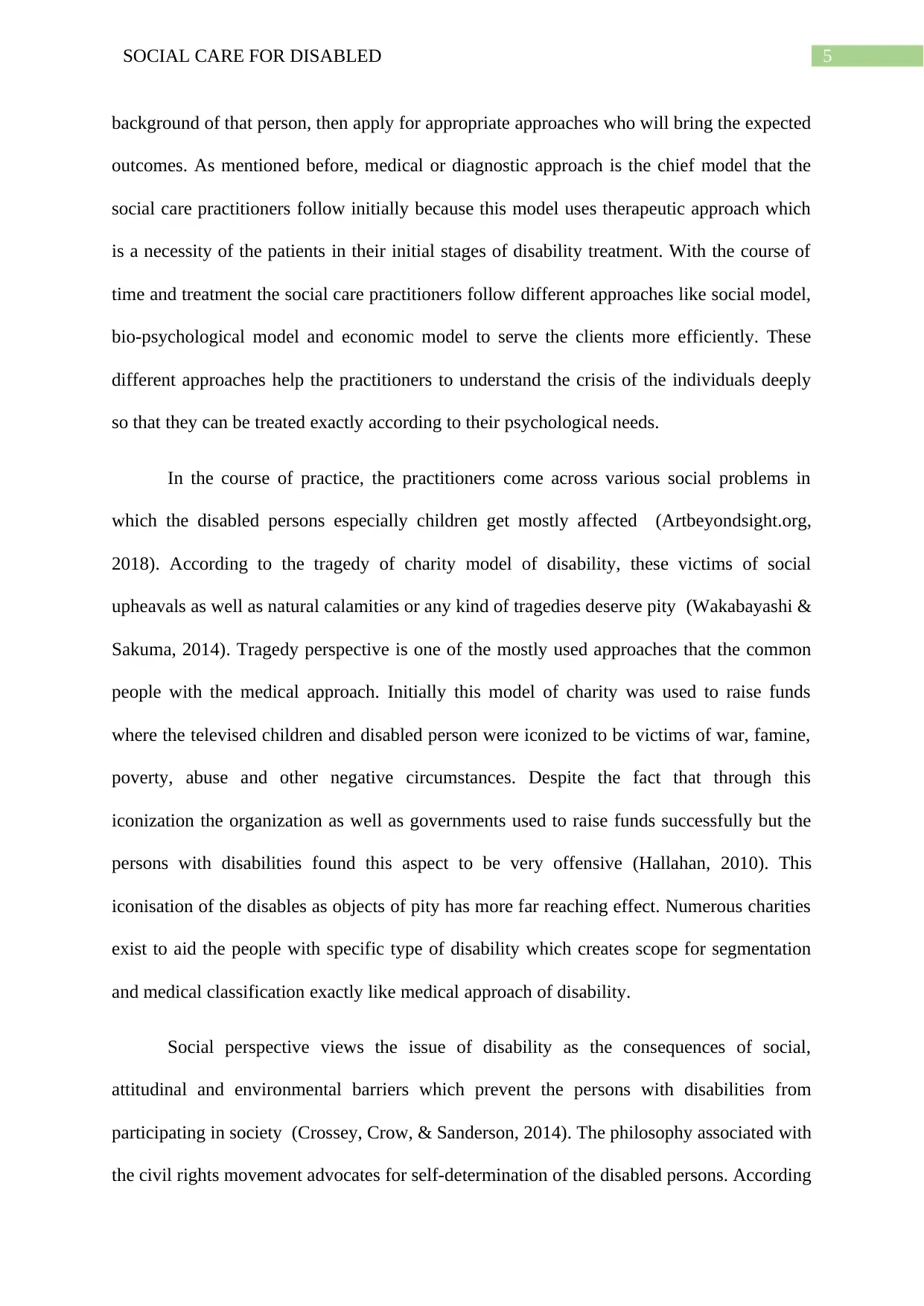
5SOCIAL CARE FOR DISABLED
background of that person, then apply for appropriate approaches who will bring the expected
outcomes. As mentioned before, medical or diagnostic approach is the chief model that the
social care practitioners follow initially because this model uses therapeutic approach which
is a necessity of the patients in their initial stages of disability treatment. With the course of
time and treatment the social care practitioners follow different approaches like social model,
bio-psychological model and economic model to serve the clients more efficiently. These
different approaches help the practitioners to understand the crisis of the individuals deeply
so that they can be treated exactly according to their psychological needs.
In the course of practice, the practitioners come across various social problems in
which the disabled persons especially children get mostly affected (Artbeyondsight.org,
2018). According to the tragedy of charity model of disability, these victims of social
upheavals as well as natural calamities or any kind of tragedies deserve pity (Wakabayashi &
Sakuma, 2014). Tragedy perspective is one of the mostly used approaches that the common
people with the medical approach. Initially this model of charity was used to raise funds
where the televised children and disabled person were iconized to be victims of war, famine,
poverty, abuse and other negative circumstances. Despite the fact that through this
iconization the organization as well as governments used to raise funds successfully but the
persons with disabilities found this aspect to be very offensive (Hallahan, 2010). This
iconisation of the disables as objects of pity has more far reaching effect. Numerous charities
exist to aid the people with specific type of disability which creates scope for segmentation
and medical classification exactly like medical approach of disability.
Social perspective views the issue of disability as the consequences of social,
attitudinal and environmental barriers which prevent the persons with disabilities from
participating in society (Crossey, Crow, & Sanderson, 2014). The philosophy associated with
the civil rights movement advocates for self-determination of the disabled persons. According
background of that person, then apply for appropriate approaches who will bring the expected
outcomes. As mentioned before, medical or diagnostic approach is the chief model that the
social care practitioners follow initially because this model uses therapeutic approach which
is a necessity of the patients in their initial stages of disability treatment. With the course of
time and treatment the social care practitioners follow different approaches like social model,
bio-psychological model and economic model to serve the clients more efficiently. These
different approaches help the practitioners to understand the crisis of the individuals deeply
so that they can be treated exactly according to their psychological needs.
In the course of practice, the practitioners come across various social problems in
which the disabled persons especially children get mostly affected (Artbeyondsight.org,
2018). According to the tragedy of charity model of disability, these victims of social
upheavals as well as natural calamities or any kind of tragedies deserve pity (Wakabayashi &
Sakuma, 2014). Tragedy perspective is one of the mostly used approaches that the common
people with the medical approach. Initially this model of charity was used to raise funds
where the televised children and disabled person were iconized to be victims of war, famine,
poverty, abuse and other negative circumstances. Despite the fact that through this
iconization the organization as well as governments used to raise funds successfully but the
persons with disabilities found this aspect to be very offensive (Hallahan, 2010). This
iconisation of the disables as objects of pity has more far reaching effect. Numerous charities
exist to aid the people with specific type of disability which creates scope for segmentation
and medical classification exactly like medical approach of disability.
Social perspective views the issue of disability as the consequences of social,
attitudinal and environmental barriers which prevent the persons with disabilities from
participating in society (Crossey, Crow, & Sanderson, 2014). The philosophy associated with
the civil rights movement advocates for self-determination of the disabled persons. According
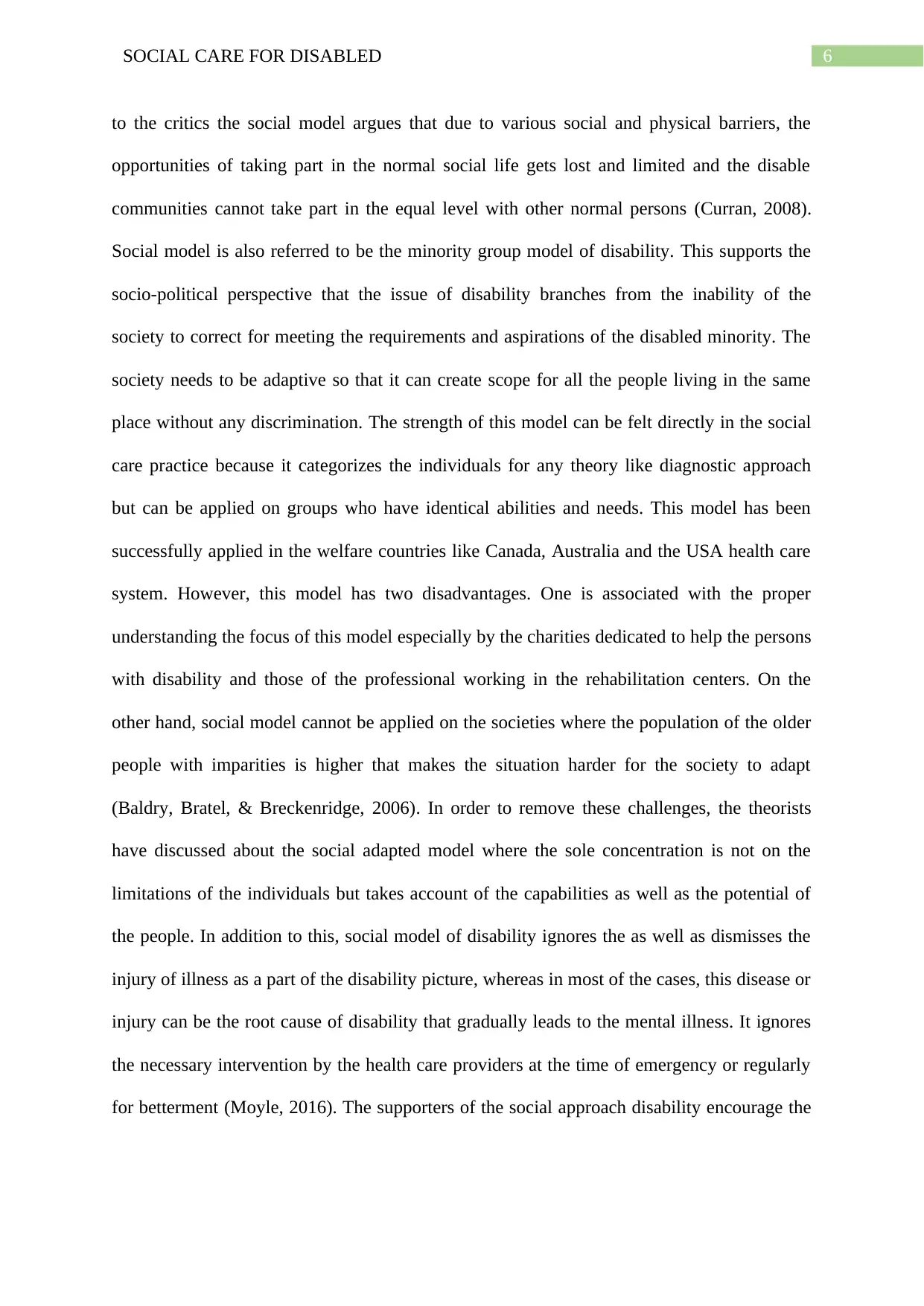
6SOCIAL CARE FOR DISABLED
to the critics the social model argues that due to various social and physical barriers, the
opportunities of taking part in the normal social life gets lost and limited and the disable
communities cannot take part in the equal level with other normal persons (Curran, 2008).
Social model is also referred to be the minority group model of disability. This supports the
socio-political perspective that the issue of disability branches from the inability of the
society to correct for meeting the requirements and aspirations of the disabled minority. The
society needs to be adaptive so that it can create scope for all the people living in the same
place without any discrimination. The strength of this model can be felt directly in the social
care practice because it categorizes the individuals for any theory like diagnostic approach
but can be applied on groups who have identical abilities and needs. This model has been
successfully applied in the welfare countries like Canada, Australia and the USA health care
system. However, this model has two disadvantages. One is associated with the proper
understanding the focus of this model especially by the charities dedicated to help the persons
with disability and those of the professional working in the rehabilitation centers. On the
other hand, social model cannot be applied on the societies where the population of the older
people with imparities is higher that makes the situation harder for the society to adapt
(Baldry, Bratel, & Breckenridge, 2006). In order to remove these challenges, the theorists
have discussed about the social adapted model where the sole concentration is not on the
limitations of the individuals but takes account of the capabilities as well as the potential of
the people. In addition to this, social model of disability ignores the as well as dismisses the
injury of illness as a part of the disability picture, whereas in most of the cases, this disease or
injury can be the root cause of disability that gradually leads to the mental illness. It ignores
the necessary intervention by the health care providers at the time of emergency or regularly
for betterment (Moyle, 2016). The supporters of the social approach disability encourage the
to the critics the social model argues that due to various social and physical barriers, the
opportunities of taking part in the normal social life gets lost and limited and the disable
communities cannot take part in the equal level with other normal persons (Curran, 2008).
Social model is also referred to be the minority group model of disability. This supports the
socio-political perspective that the issue of disability branches from the inability of the
society to correct for meeting the requirements and aspirations of the disabled minority. The
society needs to be adaptive so that it can create scope for all the people living in the same
place without any discrimination. The strength of this model can be felt directly in the social
care practice because it categorizes the individuals for any theory like diagnostic approach
but can be applied on groups who have identical abilities and needs. This model has been
successfully applied in the welfare countries like Canada, Australia and the USA health care
system. However, this model has two disadvantages. One is associated with the proper
understanding the focus of this model especially by the charities dedicated to help the persons
with disability and those of the professional working in the rehabilitation centers. On the
other hand, social model cannot be applied on the societies where the population of the older
people with imparities is higher that makes the situation harder for the society to adapt
(Baldry, Bratel, & Breckenridge, 2006). In order to remove these challenges, the theorists
have discussed about the social adapted model where the sole concentration is not on the
limitations of the individuals but takes account of the capabilities as well as the potential of
the people. In addition to this, social model of disability ignores the as well as dismisses the
injury of illness as a part of the disability picture, whereas in most of the cases, this disease or
injury can be the root cause of disability that gradually leads to the mental illness. It ignores
the necessary intervention by the health care providers at the time of emergency or regularly
for betterment (Moyle, 2016). The supporters of the social approach disability encourage the
Paraphrase This Document
Need a fresh take? Get an instant paraphrase of this document with our AI Paraphraser
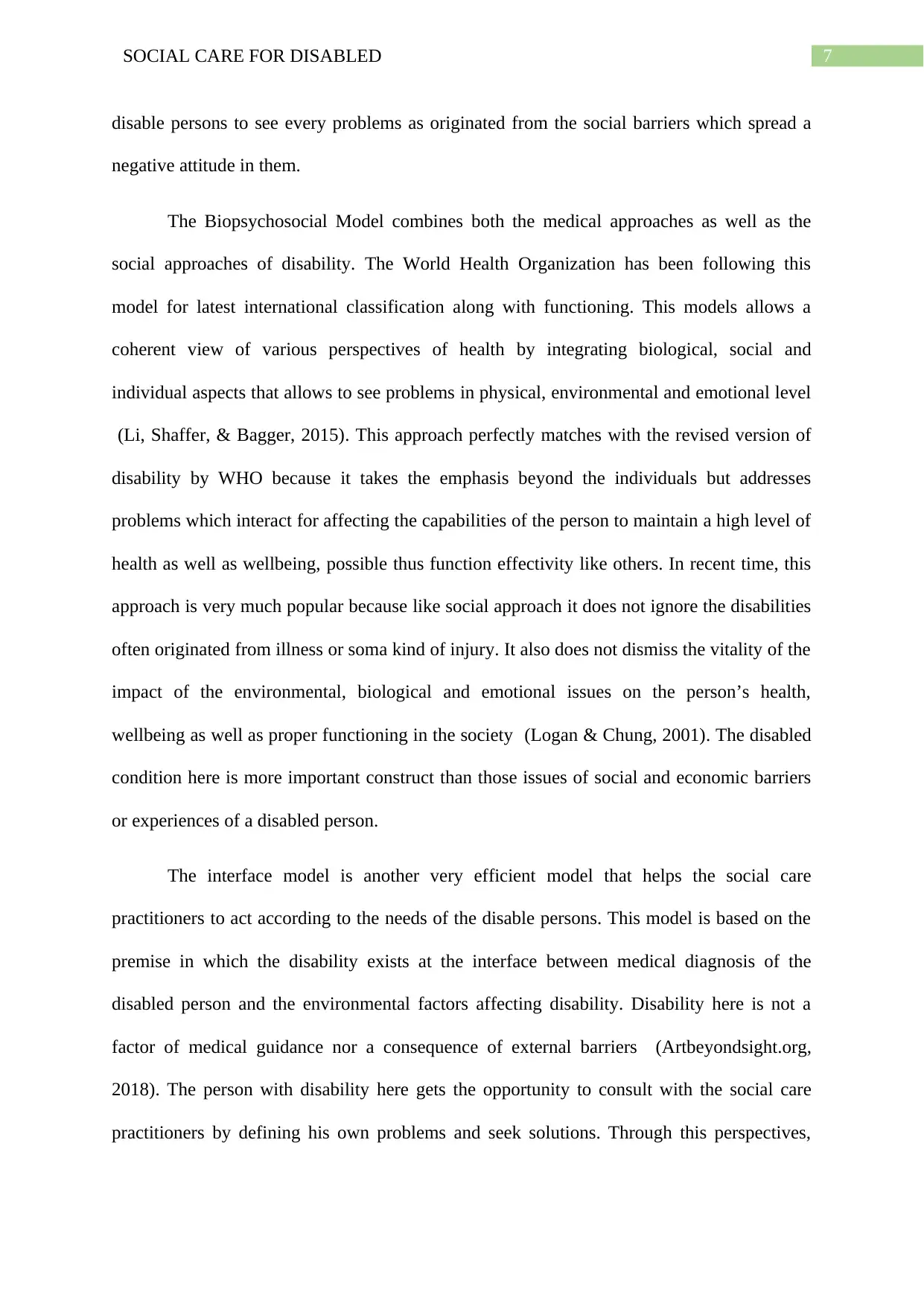
7SOCIAL CARE FOR DISABLED
disable persons to see every problems as originated from the social barriers which spread a
negative attitude in them.
The Biopsychosocial Model combines both the medical approaches as well as the
social approaches of disability. The World Health Organization has been following this
model for latest international classification along with functioning. This models allows a
coherent view of various perspectives of health by integrating biological, social and
individual aspects that allows to see problems in physical, environmental and emotional level
(Li, Shaffer, & Bagger, 2015). This approach perfectly matches with the revised version of
disability by WHO because it takes the emphasis beyond the individuals but addresses
problems which interact for affecting the capabilities of the person to maintain a high level of
health as well as wellbeing, possible thus function effectivity like others. In recent time, this
approach is very much popular because like social approach it does not ignore the disabilities
often originated from illness or soma kind of injury. It also does not dismiss the vitality of the
impact of the environmental, biological and emotional issues on the person’s health,
wellbeing as well as proper functioning in the society (Logan & Chung, 2001). The disabled
condition here is more important construct than those issues of social and economic barriers
or experiences of a disabled person.
The interface model is another very efficient model that helps the social care
practitioners to act according to the needs of the disable persons. This model is based on the
premise in which the disability exists at the interface between medical diagnosis of the
disabled person and the environmental factors affecting disability. Disability here is not a
factor of medical guidance nor a consequence of external barriers (Artbeyondsight.org,
2018). The person with disability here gets the opportunity to consult with the social care
practitioners by defining his own problems and seek solutions. Through this perspectives,
disable persons to see every problems as originated from the social barriers which spread a
negative attitude in them.
The Biopsychosocial Model combines both the medical approaches as well as the
social approaches of disability. The World Health Organization has been following this
model for latest international classification along with functioning. This models allows a
coherent view of various perspectives of health by integrating biological, social and
individual aspects that allows to see problems in physical, environmental and emotional level
(Li, Shaffer, & Bagger, 2015). This approach perfectly matches with the revised version of
disability by WHO because it takes the emphasis beyond the individuals but addresses
problems which interact for affecting the capabilities of the person to maintain a high level of
health as well as wellbeing, possible thus function effectivity like others. In recent time, this
approach is very much popular because like social approach it does not ignore the disabilities
often originated from illness or soma kind of injury. It also does not dismiss the vitality of the
impact of the environmental, biological and emotional issues on the person’s health,
wellbeing as well as proper functioning in the society (Logan & Chung, 2001). The disabled
condition here is more important construct than those issues of social and economic barriers
or experiences of a disabled person.
The interface model is another very efficient model that helps the social care
practitioners to act according to the needs of the disable persons. This model is based on the
premise in which the disability exists at the interface between medical diagnosis of the
disabled person and the environmental factors affecting disability. Disability here is not a
factor of medical guidance nor a consequence of external barriers (Artbeyondsight.org,
2018). The person with disability here gets the opportunity to consult with the social care
practitioners by defining his own problems and seek solutions. Through this perspectives,
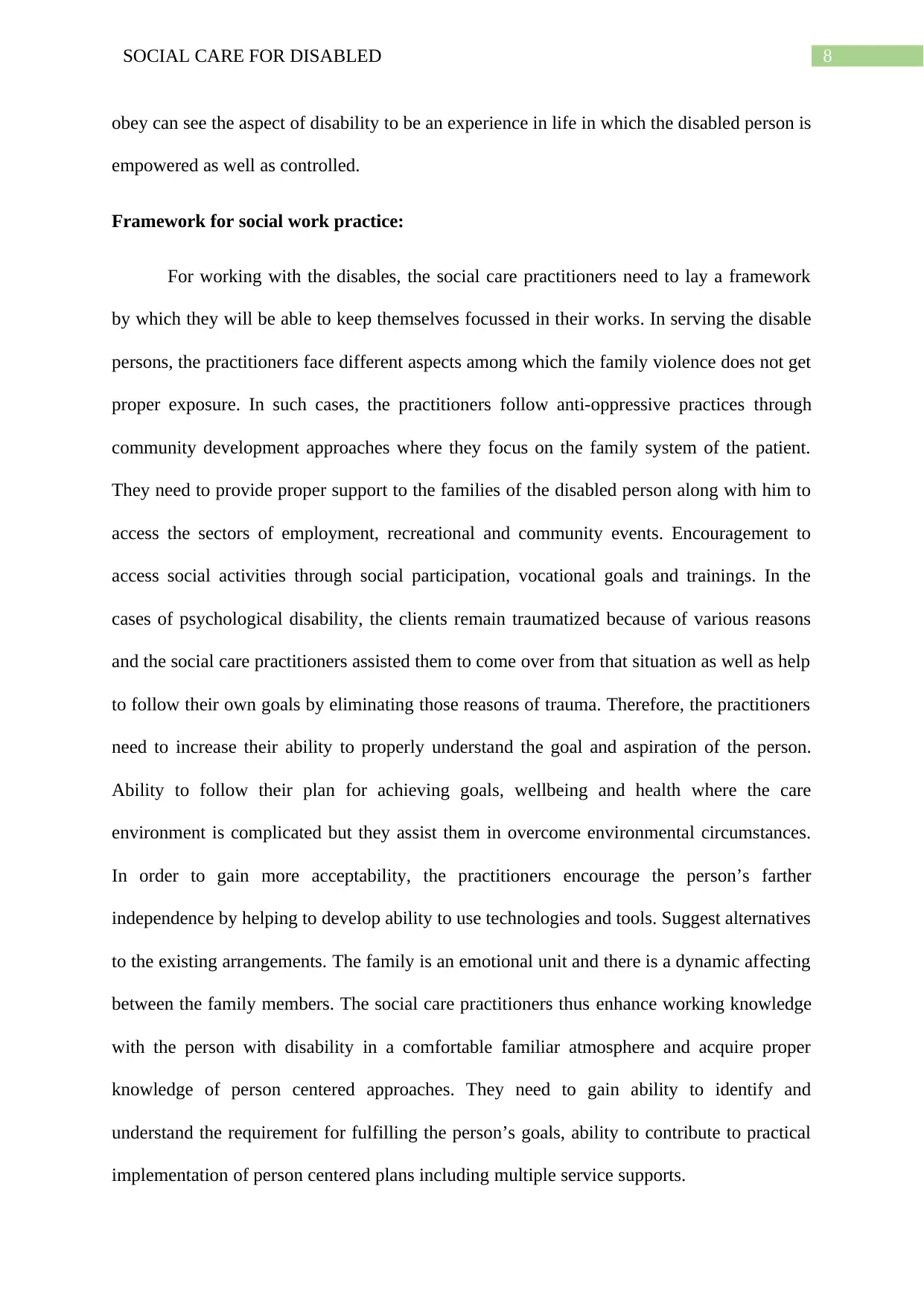
8SOCIAL CARE FOR DISABLED
obey can see the aspect of disability to be an experience in life in which the disabled person is
empowered as well as controlled.
Framework for social work practice:
For working with the disables, the social care practitioners need to lay a framework
by which they will be able to keep themselves focussed in their works. In serving the disable
persons, the practitioners face different aspects among which the family violence does not get
proper exposure. In such cases, the practitioners follow anti-oppressive practices through
community development approaches where they focus on the family system of the patient.
They need to provide proper support to the families of the disabled person along with him to
access the sectors of employment, recreational and community events. Encouragement to
access social activities through social participation, vocational goals and trainings. In the
cases of psychological disability, the clients remain traumatized because of various reasons
and the social care practitioners assisted them to come over from that situation as well as help
to follow their own goals by eliminating those reasons of trauma. Therefore, the practitioners
need to increase their ability to properly understand the goal and aspiration of the person.
Ability to follow their plan for achieving goals, wellbeing and health where the care
environment is complicated but they assist them in overcome environmental circumstances.
In order to gain more acceptability, the practitioners encourage the person’s farther
independence by helping to develop ability to use technologies and tools. Suggest alternatives
to the existing arrangements. The family is an emotional unit and there is a dynamic affecting
between the family members. The social care practitioners thus enhance working knowledge
with the person with disability in a comfortable familiar atmosphere and acquire proper
knowledge of person centered approaches. They need to gain ability to identify and
understand the requirement for fulfilling the person’s goals, ability to contribute to practical
implementation of person centered plans including multiple service supports.
obey can see the aspect of disability to be an experience in life in which the disabled person is
empowered as well as controlled.
Framework for social work practice:
For working with the disables, the social care practitioners need to lay a framework
by which they will be able to keep themselves focussed in their works. In serving the disable
persons, the practitioners face different aspects among which the family violence does not get
proper exposure. In such cases, the practitioners follow anti-oppressive practices through
community development approaches where they focus on the family system of the patient.
They need to provide proper support to the families of the disabled person along with him to
access the sectors of employment, recreational and community events. Encouragement to
access social activities through social participation, vocational goals and trainings. In the
cases of psychological disability, the clients remain traumatized because of various reasons
and the social care practitioners assisted them to come over from that situation as well as help
to follow their own goals by eliminating those reasons of trauma. Therefore, the practitioners
need to increase their ability to properly understand the goal and aspiration of the person.
Ability to follow their plan for achieving goals, wellbeing and health where the care
environment is complicated but they assist them in overcome environmental circumstances.
In order to gain more acceptability, the practitioners encourage the person’s farther
independence by helping to develop ability to use technologies and tools. Suggest alternatives
to the existing arrangements. The family is an emotional unit and there is a dynamic affecting
between the family members. The social care practitioners thus enhance working knowledge
with the person with disability in a comfortable familiar atmosphere and acquire proper
knowledge of person centered approaches. They need to gain ability to identify and
understand the requirement for fulfilling the person’s goals, ability to contribute to practical
implementation of person centered plans including multiple service supports.
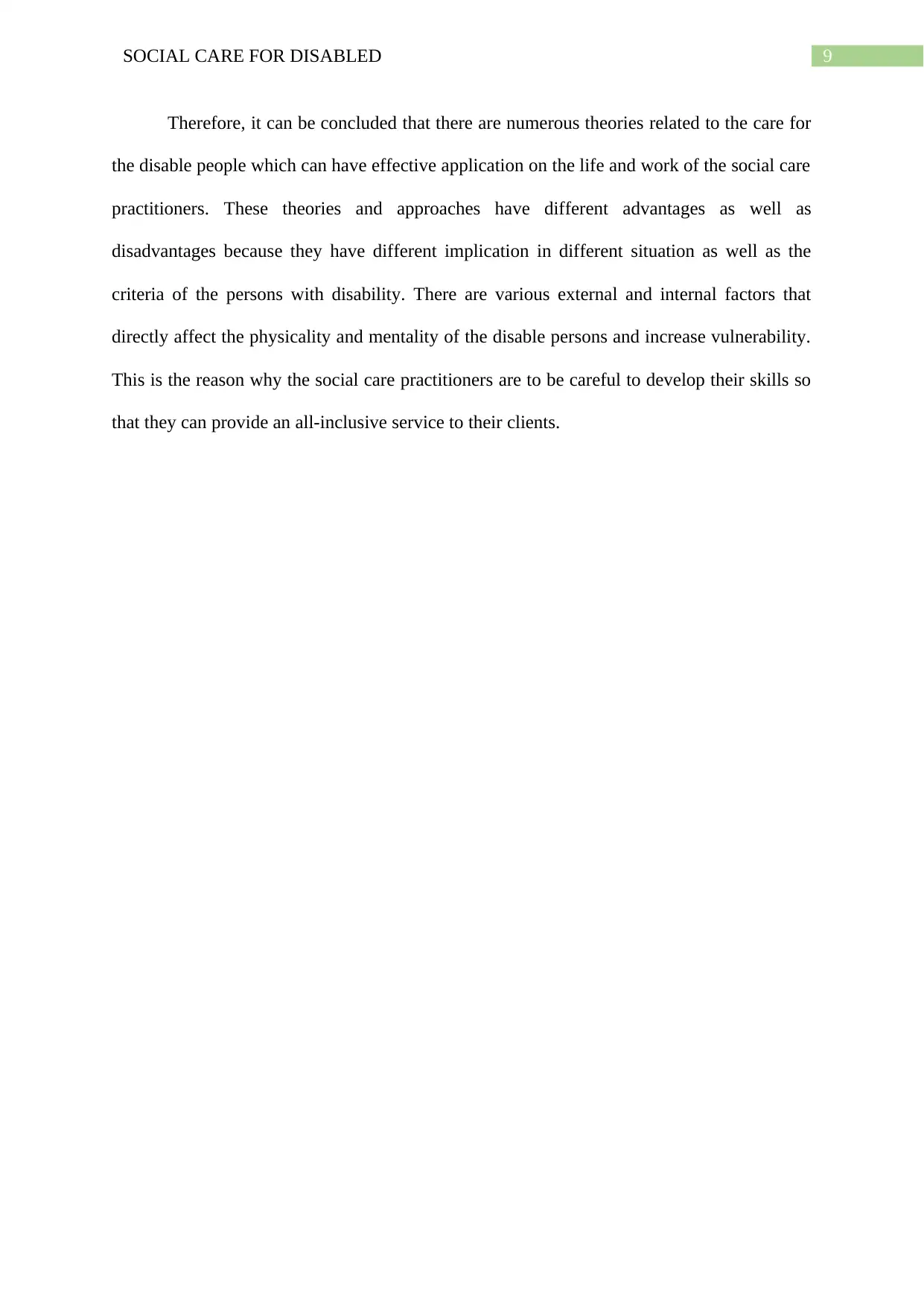
9SOCIAL CARE FOR DISABLED
Therefore, it can be concluded that there are numerous theories related to the care for
the disable people which can have effective application on the life and work of the social care
practitioners. These theories and approaches have different advantages as well as
disadvantages because they have different implication in different situation as well as the
criteria of the persons with disability. There are various external and internal factors that
directly affect the physicality and mentality of the disable persons and increase vulnerability.
This is the reason why the social care practitioners are to be careful to develop their skills so
that they can provide an all-inclusive service to their clients.
Therefore, it can be concluded that there are numerous theories related to the care for
the disable people which can have effective application on the life and work of the social care
practitioners. These theories and approaches have different advantages as well as
disadvantages because they have different implication in different situation as well as the
criteria of the persons with disability. There are various external and internal factors that
directly affect the physicality and mentality of the disable persons and increase vulnerability.
This is the reason why the social care practitioners are to be careful to develop their skills so
that they can provide an all-inclusive service to their clients.
Secure Best Marks with AI Grader
Need help grading? Try our AI Grader for instant feedback on your assignments.
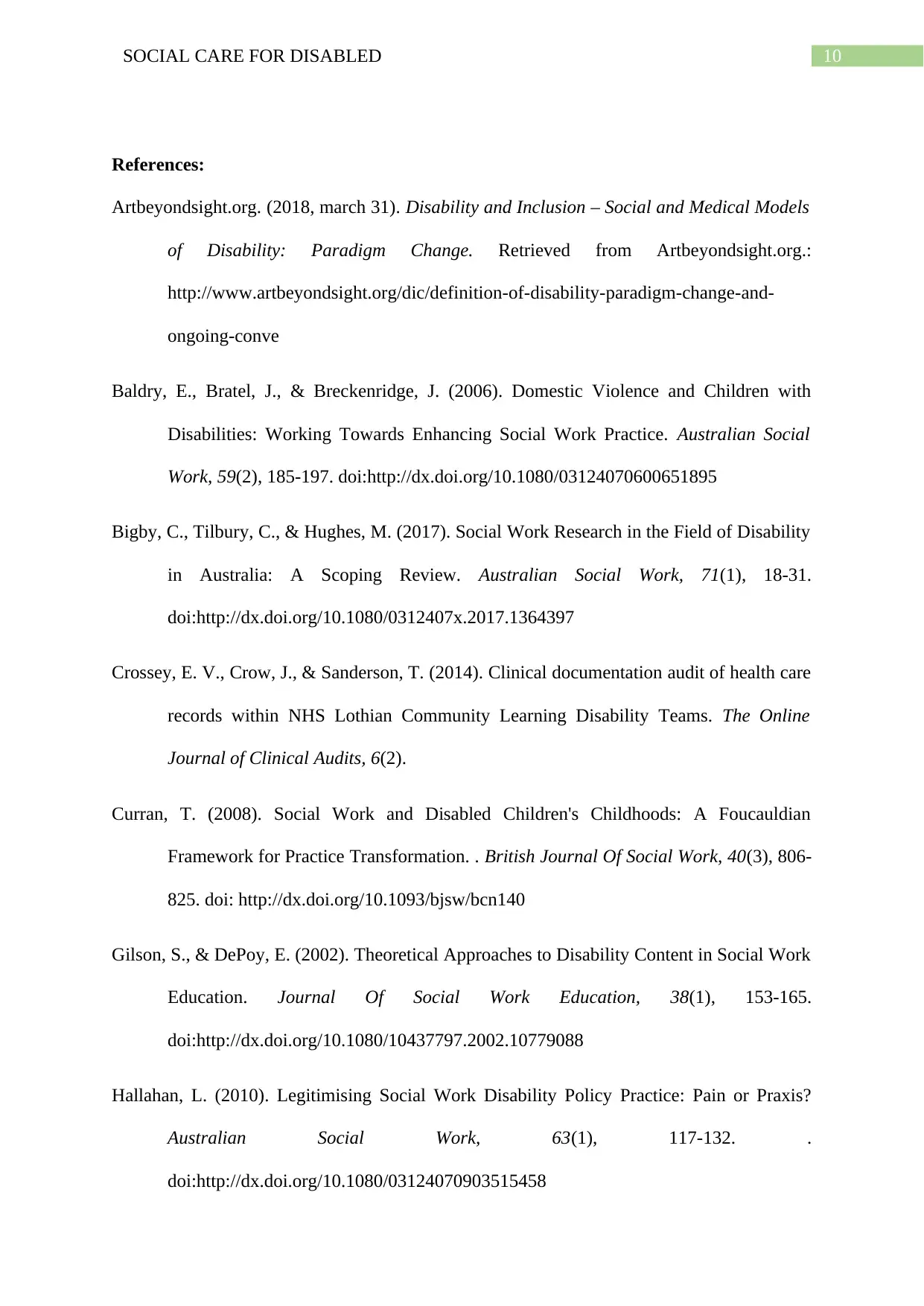
10SOCIAL CARE FOR DISABLED
References:
Artbeyondsight.org. (2018, march 31). Disability and Inclusion – Social and Medical Models
of Disability: Paradigm Change. Retrieved from Artbeyondsight.org.:
http://www.artbeyondsight.org/dic/definition-of-disability-paradigm-change-and-
ongoing-conve
Baldry, E., Bratel, J., & Breckenridge, J. (2006). Domestic Violence and Children with
Disabilities: Working Towards Enhancing Social Work Practice. Australian Social
Work, 59(2), 185-197. doi:http://dx.doi.org/10.1080/03124070600651895
Bigby, C., Tilbury, C., & Hughes, M. (2017). Social Work Research in the Field of Disability
in Australia: A Scoping Review. Australian Social Work, 71(1), 18-31.
doi:http://dx.doi.org/10.1080/0312407x.2017.1364397
Crossey, E. V., Crow, J., & Sanderson, T. (2014). Clinical documentation audit of health care
records within NHS Lothian Community Learning Disability Teams. The Online
Journal of Clinical Audits, 6(2).
Curran, T. (2008). Social Work and Disabled Children's Childhoods: A Foucauldian
Framework for Practice Transformation. . British Journal Of Social Work, 40(3), 806-
825. doi: http://dx.doi.org/10.1093/bjsw/bcn140
Gilson, S., & DePoy, E. (2002). Theoretical Approaches to Disability Content in Social Work
Education. Journal Of Social Work Education, 38(1), 153-165.
doi:http://dx.doi.org/10.1080/10437797.2002.10779088
Hallahan, L. (2010). Legitimising Social Work Disability Policy Practice: Pain or Praxis?
Australian Social Work, 63(1), 117-132. .
doi:http://dx.doi.org/10.1080/03124070903515458
References:
Artbeyondsight.org. (2018, march 31). Disability and Inclusion – Social and Medical Models
of Disability: Paradigm Change. Retrieved from Artbeyondsight.org.:
http://www.artbeyondsight.org/dic/definition-of-disability-paradigm-change-and-
ongoing-conve
Baldry, E., Bratel, J., & Breckenridge, J. (2006). Domestic Violence and Children with
Disabilities: Working Towards Enhancing Social Work Practice. Australian Social
Work, 59(2), 185-197. doi:http://dx.doi.org/10.1080/03124070600651895
Bigby, C., Tilbury, C., & Hughes, M. (2017). Social Work Research in the Field of Disability
in Australia: A Scoping Review. Australian Social Work, 71(1), 18-31.
doi:http://dx.doi.org/10.1080/0312407x.2017.1364397
Crossey, E. V., Crow, J., & Sanderson, T. (2014). Clinical documentation audit of health care
records within NHS Lothian Community Learning Disability Teams. The Online
Journal of Clinical Audits, 6(2).
Curran, T. (2008). Social Work and Disabled Children's Childhoods: A Foucauldian
Framework for Practice Transformation. . British Journal Of Social Work, 40(3), 806-
825. doi: http://dx.doi.org/10.1093/bjsw/bcn140
Gilson, S., & DePoy, E. (2002). Theoretical Approaches to Disability Content in Social Work
Education. Journal Of Social Work Education, 38(1), 153-165.
doi:http://dx.doi.org/10.1080/10437797.2002.10779088
Hallahan, L. (2010). Legitimising Social Work Disability Policy Practice: Pain or Praxis?
Australian Social Work, 63(1), 117-132. .
doi:http://dx.doi.org/10.1080/03124070903515458
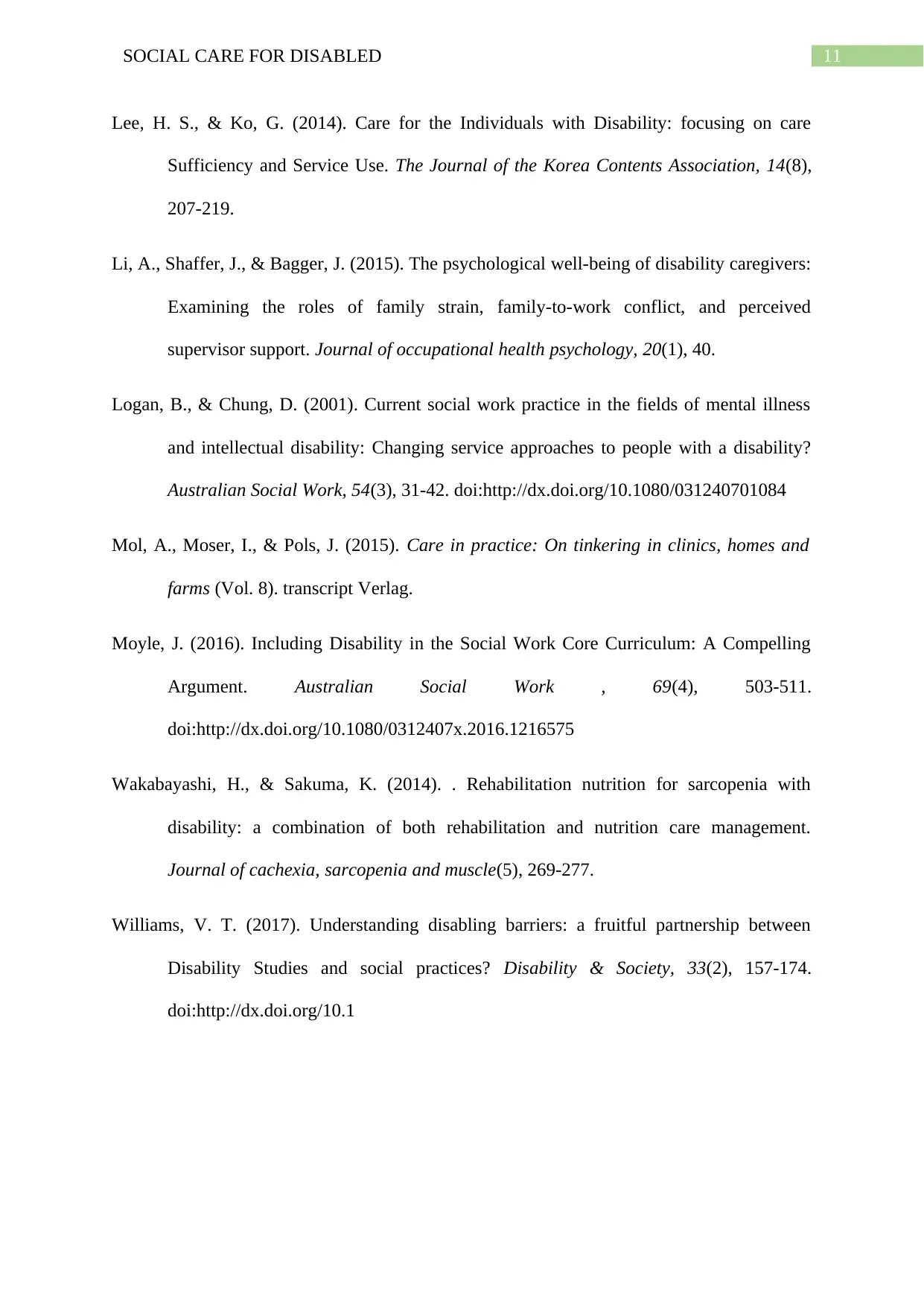
11SOCIAL CARE FOR DISABLED
Lee, H. S., & Ko, G. (2014). Care for the Individuals with Disability: focusing on care
Sufficiency and Service Use. The Journal of the Korea Contents Association, 14(8),
207-219.
Li, A., Shaffer, J., & Bagger, J. (2015). The psychological well-being of disability caregivers:
Examining the roles of family strain, family-to-work conflict, and perceived
supervisor support. Journal of occupational health psychology, 20(1), 40.
Logan, B., & Chung, D. (2001). Current social work practice in the fields of mental illness
and intellectual disability: Changing service approaches to people with a disability?
Australian Social Work, 54(3), 31-42. doi:http://dx.doi.org/10.1080/031240701084
Mol, A., Moser, I., & Pols, J. (2015). Care in practice: On tinkering in clinics, homes and
farms (Vol. 8). transcript Verlag.
Moyle, J. (2016). Including Disability in the Social Work Core Curriculum: A Compelling
Argument. Australian Social Work , 69(4), 503-511.
doi:http://dx.doi.org/10.1080/0312407x.2016.1216575
Wakabayashi, H., & Sakuma, K. (2014). . Rehabilitation nutrition for sarcopenia with
disability: a combination of both rehabilitation and nutrition care management.
Journal of cachexia, sarcopenia and muscle(5), 269-277.
Williams, V. T. (2017). Understanding disabling barriers: a fruitful partnership between
Disability Studies and social practices? Disability & Society, 33(2), 157-174.
doi:http://dx.doi.org/10.1
Lee, H. S., & Ko, G. (2014). Care for the Individuals with Disability: focusing on care
Sufficiency and Service Use. The Journal of the Korea Contents Association, 14(8),
207-219.
Li, A., Shaffer, J., & Bagger, J. (2015). The psychological well-being of disability caregivers:
Examining the roles of family strain, family-to-work conflict, and perceived
supervisor support. Journal of occupational health psychology, 20(1), 40.
Logan, B., & Chung, D. (2001). Current social work practice in the fields of mental illness
and intellectual disability: Changing service approaches to people with a disability?
Australian Social Work, 54(3), 31-42. doi:http://dx.doi.org/10.1080/031240701084
Mol, A., Moser, I., & Pols, J. (2015). Care in practice: On tinkering in clinics, homes and
farms (Vol. 8). transcript Verlag.
Moyle, J. (2016). Including Disability in the Social Work Core Curriculum: A Compelling
Argument. Australian Social Work , 69(4), 503-511.
doi:http://dx.doi.org/10.1080/0312407x.2016.1216575
Wakabayashi, H., & Sakuma, K. (2014). . Rehabilitation nutrition for sarcopenia with
disability: a combination of both rehabilitation and nutrition care management.
Journal of cachexia, sarcopenia and muscle(5), 269-277.
Williams, V. T. (2017). Understanding disabling barriers: a fruitful partnership between
Disability Studies and social practices? Disability & Society, 33(2), 157-174.
doi:http://dx.doi.org/10.1

12SOCIAL CARE FOR DISABLED
1 out of 13
Related Documents
Your All-in-One AI-Powered Toolkit for Academic Success.
+13062052269
info@desklib.com
Available 24*7 on WhatsApp / Email
![[object Object]](/_next/static/media/star-bottom.7253800d.svg)
Unlock your academic potential
© 2024 | Zucol Services PVT LTD | All rights reserved.





